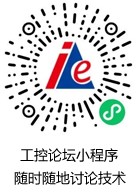FeaturesoftheS7-200 点击:158 | 回复:0
Features of the S7-200
The S7-200 provides several special features that allow you to customize how the S7-200 functions to better fit your application.
The S7-200 Allows Your Program to Immediately Read or Write the I/O
The S7-200 instruction set provides instructions that immediately read from or write to the physical I/O. These immediate I/O instructions allow direct access to the actual input or output point, even though the image registers are normally used as either the source or the destination for I/O accesses.
The corresponding process-image input register location is not modified when you use an immediate instruction to access an input point. The corresponding process-image output register location is updated simultaneously when you use an immediate instruction to access an output point.
Tip
The S7-200 handles reads of analog inputs as immediate data, unless you enable analog input filtering. When you write a value to an analog output, the output is updated immediately.
It is usually advantageous to use the process-image register rather than to directly access inputs or outputs during the execution of your program. There are three reasons for using the image registers:
- The sampling of all inputs at the start of the scan synchronizes and freezes the values of the inputs for the program execution phase of the scan cycle. The outputs are updated from the image register after the execution of the program is complete. This provides a stabilizing effect on the system.
- Your program can access the image register much more quickly than it can access I/O points, allowing faster execution of the program.
- I/O points are bit entities and must be accessed as bits or bytes, but you can access the image register as bits, bytes, words, or double words. Thus, the image registers provide additional flexibility.
The S7-200 Allows You to Set the States of Digital Outputs for Stop Mode
The output table of the S7-200 allows you to determine whether to set the state of the digital output points to known values upon a transition to the STOP mode, or to leave the outputs in the state they were in before the transition to the STOP mode. The output table is part of the system block that is downloaded and stored in the S7-200. 1. Select the View > Component > System Block menu command and select Output Table. Click on the Digital tab.
2. To freeze the outputs in their last state, select the Freeze Outputs checkbox.
3. To copy the table values to the outputs, enter the output table values by clicking the checkbox for each output bit you want to set to On (1) after a run-to-stop transition. The default values of the table are all zeroes. 4. Click OK to save your selections.
5. Download the modified system block to the S7-200.
Figure 2 Digital Output Table
The S7-200 Allows You to Configure the Value of Analog Outputs
The Analog Output Table allows you to set analog output points to known values after a
RUN-to-STOP transition, or to preserve the output values that existed before the transition to
STOP mode. The Analog Output table is part of the system block that is downloaded
and stored in the S7-200 CPU.
1. Select the View > Component > System Block menu command and select Output Table. Click on the Analog tab.
2. To freeze the outputs in their last state, select the Freeze Outputs check box.
3. The Freeze Values table allows you to set the analog outputs to a known value (--32768 to 37262), on a RUN-to-STOP transition. 4. Click OK to save your selections.
5. Download the modified system block to the S7-200.
Figure 3 Analog Output Table
The S7-200 Allows You to Catch Pulses of Short Duration
The S7-200 provides a pulse catch feature which can be used for some or all of the local digital input points. The pulse catch feature allows you to capture high-going pulses or low-going pulses that are of such a short duration that they would not always be seen when the S7-200 reads the digital inputs at the beginning of the scan cycle. When pulse catch is enabled for an input, a change in state of the input is latched and held until the next input cycle update. This ensures that a pulse which lasts for a short period of time is caught and held until the S7-200 reads the inputs.
You can individually enable the pulse catch operation for each of the local digital inputs.
- 永宏PLC案例100案例(完整版
 [10674]
[10674] - 西门子S7-200 Smart PLC如何...
 [10238]
[10238] - 求助:mwp文件怎么打开?
 [25171]
[25171] - 用PLC怎样控制伺服电机按正弦...
 [7910]
[7910] - 西门子PLC200如何做一个延时...
 [27934]
[27934] - 求助PLC如何存储大量数据
 [11720]
[11720] - 国产PLC 图片
 [14979]
[14979] - 2019年第一个项目——简述
 [7731]
[7731] - VB接收到PLC的十六进制码如何...
 [9239]
[9239] - 日本欧姆龙PLC应用经验点滴
 [7564]
[7564]

官方公众号

智造工程师
-

 客服
客服

-

 小程序
小程序

-

 公众号
公众号

















 工控网智造工程师好文精选
工控网智造工程师好文精选
